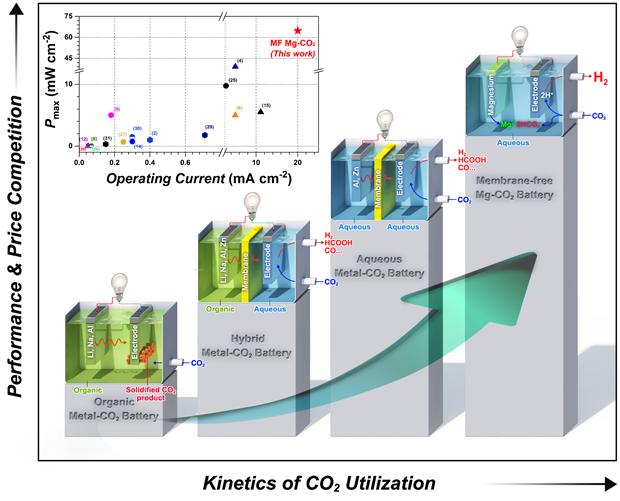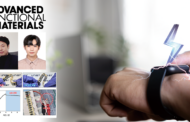A recent study, affiliated with UNIST has unveiled a novel system, capable of producing hydrogen and electricity quickly and effectively while eliminating carbon dioxide (CO₂) emissions significantly.
Published in the January 2021 issue of Nano Energy, this breakthrough has been carried out by Professor GunTae Kim and his research team in the School of Energy and Chemical Engineering at UNIST. In this study, the research team succeeded in developing a membrane-free aqueous metal–CO₂ battery. Unlike the existing aqueous metal–CO₂ systems, the new battery is not only easier to manufacture, but also allows continuous operation with one type of electrolyte.

Figure 1. Schematic configuration and operation principle for each battery system from organic to membrane-free battery.
The research team designed a membrane-free (MF) Mg-CO2 battery, as an advanced approach to sequester CO2 emissions by generating electricity and value-added chemicals without any harmful by-products. According to the research team, their MF Mg-CO2 battery operates based on the indirect utilization of CO2 with facile hydrogen generation process. It has been also found that the new battery exhibits high faradaic efficiency of 92.0%.
“In order to translate the newly-developed laboratory-scale MF Mg-CO2 battery technology into a commercial reality, we have envisioned an operational prototype system that produces electricity and value-added chemicals, as a cornerstone to better support sustainable human life from CO2 and earth-abundant renewable power (e.g., wind, solar, seawater),” noted the research team.

Figure 2. (a) Schematic illustration of MF Mg-CO2 battery. (b) The XRD profile of the precipitated white solid after discharge process in CO2 sat’d condition and N2 sat’d condition.
The MF Mg-CO2 battery system has a structure similar to that of hydrogen fuel cells for use in cars, since it only requires a Mg-metal negative electrode, an aqueous electrolyte, and a positive-electrode catalyst. However, unlike the existing fuel cells, they are based on aqueous electrolytes. As a result, the newly-developed MF Mg-CO2 battery had successfully sequestered CO2 emissions by generating electricity and value-added chemicals without any harmful by-products.
“Our findings indicate great benefits for the newly-developed MF Mg-CO2 battery technology to produce various value-added chemicals of practical significance and electricity from CO2 without any wasted by-products,” noted the research team. “Through this we have opened the door to electrochemical utilization of CO2 with indirect circulation for future alternative technologies.”
Journal Reference
Jeongwon Kim, Arim Seong, Yejin Yang, et al., “Indirect surpassing CO2 utilization in membrane-free CO2 battery,” Nano Energy, (2021).
















Pingback: Fresh system to create hydrogen and electrical energy rapid and successfully - Toronto Star Finance()
Pingback: New system to produce hydrogen and electricity quickly and effectively - Information Driven()
Pingback: Novel system sequesters CO2 and generates electricity | Masoud ILDEREMI()
Pingback: Novel system sequesters CO2 and generates electricity -- ScienceDaily()
Pingback: Novel system sequesters CO2 and generates electricity - ScienceDaily - Classified Mind()
Pingback: Novel system sequesters CO2 and generates electricity | Latest News Channel()
Pingback: Novel system sequesters CO2 and generates electricity – Foogle India()
Pingback: Novel system sequesters CO2 and generates electricity()
Pingback: Indirect Surpassing CO2 Utilization in Membrane-Free CO2 Battery −()
Pingback: Oblique Surpassing CO2 Utilization in Membrane-Free CO2 Battery − | Gadget News Plus()
Pingback: Novel system sequesters CO2 and generates electricity - ScienceDaily - Night Vision Now()